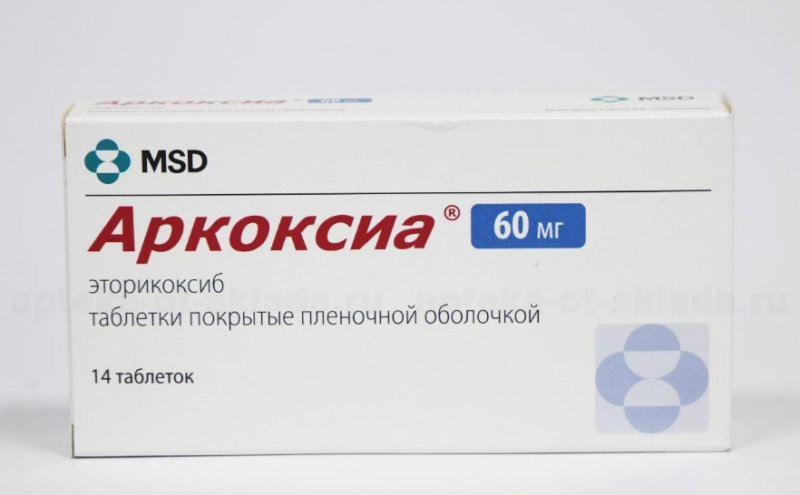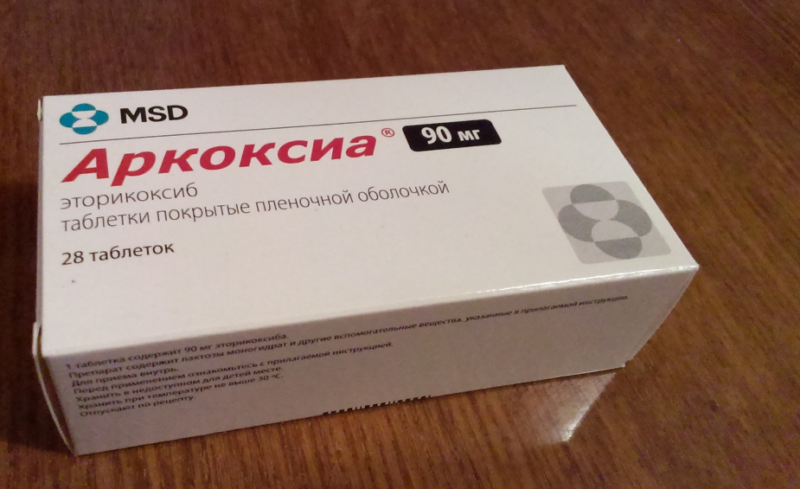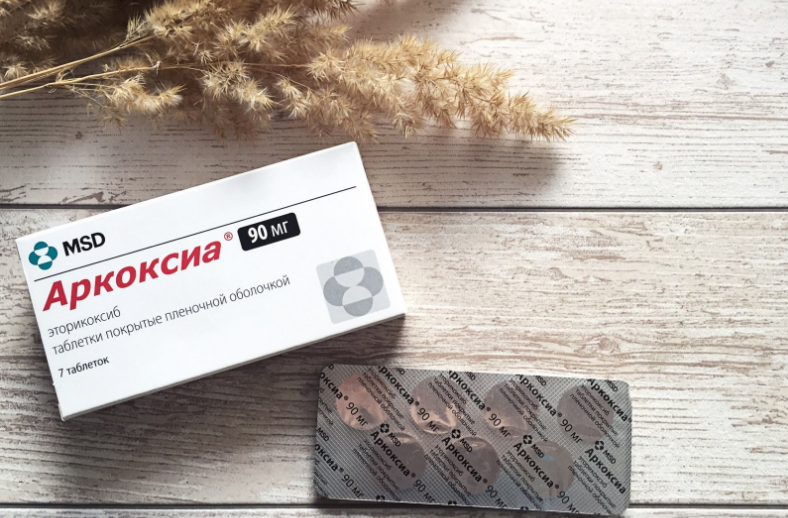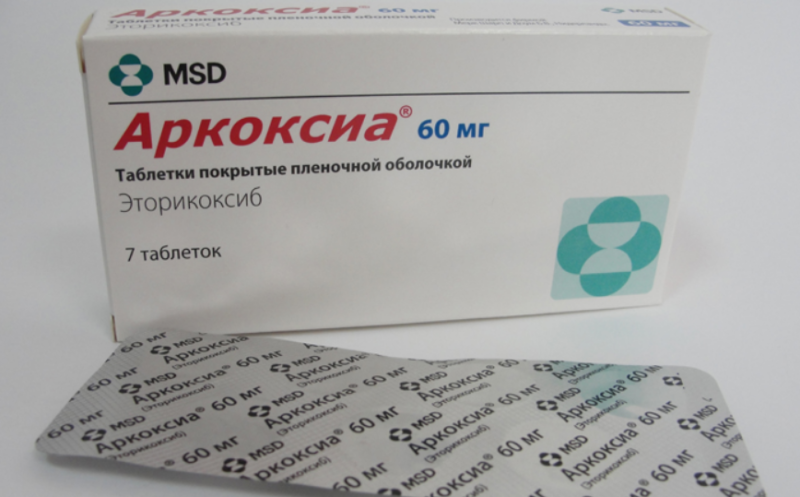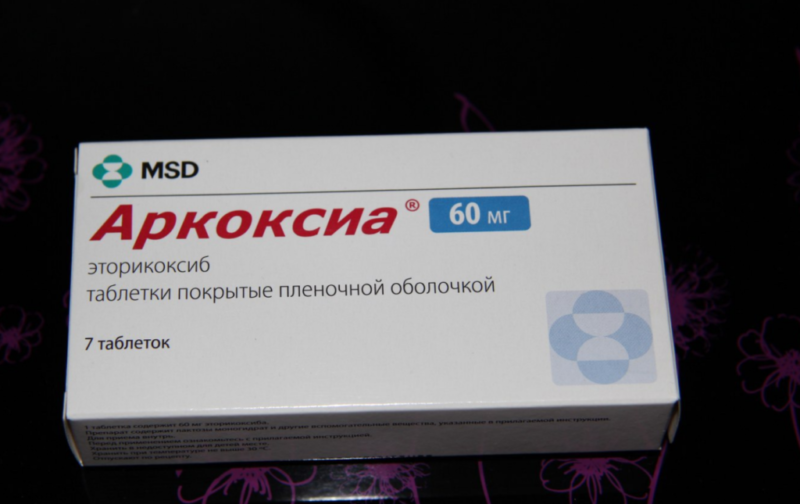Arcoxia is a highly active, fast-acting non-hormonal anti-inflammatory medication with pronounced analgesic properties and a long-lasting effect. It is mainly used for joint inflammatory pain syndromes. Belongs to the class of highly selective coxibs (COX) - inhibitors of the COX-2 enzyme.
The medicine is evaluated as an alternative to "traditional" non-hormonal anti-inflammatory drugs (NSAIDs), since it shows the least effect on the digestive organs and a stronger therapeutic effect. This expands the possibility of using pharmaceuticals in patients with gastrointestinal diseases.
Material Content:
- 1 Description of the release form and composition
- 2 Pharmacological action, pharmacodynamics and pharmacokinetics
- 3 What helps Arcoxia
- 4 Instructions for use and dosage of tablets
- 5 During pregnancy and lactation
- 6 Alcohol compatibility
- 7 Drug interaction
- 8 Contraindications, side effects and overdose
- 9 Analogs of NSAIDs
Description of the release form and composition
The drug is produced in the form of tablets in a soluble shell with a wide range of therapeutic dosages.
The component that has an active healing effect is etoricoxib.
Arcoxia 90 mg tablets are placed in paper packaging of 7 and 28 units, medicine with a dosage of 60 mg - 14 and 28 units, tablets with an increased amount of the active component of 120 mg are packed in 7 pieces. A reduced dosage form of 30 mg (28 tablets) is also produced.
The drug includes inactive components as food dyes, preservatives and formative substances.
Pharmacological action, pharmacodynamics and pharmacokinetics
The significant analgesic, anti-inflammatory, antipyretic therapeutic effect of Arkoksia is based on the property of the drug to selectively suppress the activity of the isoform of the special enzyme COX-2, which is intensively produced in the area of any tissue damage, increasing the concentration of hormone-like substances of prostaglandins (PG) involved in the formation of inflammatory and pain manifestations.
The advantage of Arcoxia in comparison with conventional NSAIDs - non-steroidal anti-inflammatory pharmaceuticals, for example, Diclofenac, lies in the fact that the medication has almost no effect on the COX-1 isoform, which is necessary to maintain the stability of the stomach and intestinal mucosa to the destructive effect of hydrochloric acid, bacteria, and protect it from ulceration. Standard NSAIDs also reduce mucosal protection and treatment with them often leads to severe damage, perforation of ulcers, bleeding. In addition, etoricoxib, unlike standard NSAIDs, does not cause such a common complication as an attack of “aspirin” asthma.
Another advantage of the drug is the maximum manifestation of the analgesic effect, since the drug is very fast absorbed and bioavailable - almost 100% of the treatment substance reaches the focus of inflammation in the interval 1-3 hours after it enters the body. Moreover, the analgesic effectiveness of the smallest therapeutic dose of etoricoxib is almost equal to the effect of the maximum dose of Diclofenac.
The elimination time of half of the active substance that has got inside is about 20-22 hours, which guarantees a stable analgesic and anti-inflammatory effect for 1 day after a single dose.
It is removed from the body with urine.
What helps Arcoxia
Universal coxib has established itself as an effective tool that is also used for urgent pain relief in acute injuries, after orthopedic, dental surgical interventions, and as one of the medications in the treatment of chronic rheumatic pathologies.
Arkoxia medicine helps to reduce pain and signs of inflammation with such pathologies:
- deforming osteoarthrosis;
- rheumatoid, psoriatic arthritis;
- gout in the acute and chronic phase;
- progressive inflammation between the vertebrae (ankylosing spondylitis);
- pain syndrome (moderate and intense) after surgical interventions in orthopedics and dentistry.
It should be understood that the medication does not eliminate the root cause of pathologies, but only effectively eliminates pathological symptoms.
Instructions for use and dosage of tablets
The drug is used without regard to food intake, once a day, which ensures ease of use. You can drink the tablets with water, tea, compote, milk, jelly in the amount that the patient chooses.
But it is worth considering that if the medicine is taken with food, then the maximum content of the treating substance in the blood decreases by 30–35%, and the time to achieve a pronounced therapeutic effect increases by 2 hours. Therefore, in acute conditions, a medication is indicated between meals.
To minimize possible unwanted reactions, it is worth starting the therapy with the lowest dosage showing an obvious therapeutic result, and if possible reduce the course of administration to 2-3 days.
If arthrosis is diagnosed, then to eliminate the painful symptoms, treatment begins with a dose of 30 mg per day. With severe pain and acute inflammatory phenomena, it is allowed to increase the amount of etoricoxib to 60 mg, which will significantly facilitate the patient's condition.
With spondylitis and arthritis, the daily dosage of Arcoxia is increased to 90 mg. Acute manifestations require an increase in the dose of the drug to 120 mg (the maximum allowable amount of etoricoxib) in 24 hours.
Reception of 120 mg cannot last more than 8 days.
To relieve intense painful symptoms after orthopedic, dental interventions or trauma, 90 mg is required.
To relieve acute joint pain, including gouty, it is allowed to increase the amount of etoricoxib to 120 mg.
In the treatment of patients with chronic pain, functional liver failure, the maximum daily dose is reduced to 60 mg.
Important! It is highly undesirable to increase the permitted doses of etoricoxib, since this will not lead to an increase in the therapeutic effect, but will only cause adverse reactions or increase the degree of their manifestation.
You should not drink pills on your own with all kinds of pain. When prescribing a painkiller medication, the specialist must take into account the diagnosis, indications for use, conditions in which it is forbidden to use Acroxia.
Important recommendations:
- Although Arcoxia, to a much lesser extent than other NSAIDs, affects the stomach and intestines, people with gastritis, prone to gastrointestinal ulcers, with gastrointestinal bleeding, are strongly advised to take medications from the class of proton pump blockers (Omeprazole, Lansoprazole, Esomeprazole, Gastrozole, Omez, Rabeprazole), which prevent complications in the digestive tract.
- Since Arcoxia can cause adverse reactions from the heart, blood vessels, with a tendency to cerebrovascular and cardiac diseases, as well as people with diabetes, pharmaceuticals with a small amount of acetylsalicylic acid (Thrombo Ass) are needed.
- In case of violation of the metabolism of milk sugar, it should be borne in mind that lactose is part of Arcoxia.
If in the course of treatment there are moments of drowsiness, muscle weakness, dizziness, it is advisable for patients to avoid activities that require precise movements, special attention and reaction speed (air traffic controllers, drivers, machinists).
During pregnancy and lactation
It is forbidden to prescribe a medication to expectant mothers and nursing patients.
The active component penetrates the bloodstream of the fetus, breast milk and is able to adversely affect the development of the embryo and the health of the breastfed infant. Moreover, coxib negatively affects reproductive functions, therefore gynecologists strongly do not recommend taking it to women planning to conceive or stop taking it 2-3 months before the planned pregnancy.
Alcohol compatibility
Arcoxia and alcohol are seen by experts as an extremely undesirable combination. Ethanol during the course of Akkroksia must be excluded, since depending on alcohol in patients, the liver is necessarily affected to one degree or another, and taking medication can enhance the pathology.
Drug interaction
With concomitant therapy with other drugs, Arcoxia can cause negative symptoms that weaken the therapeutic effect or lead to organic and functional disorders.
| Medications | Effects in combination with Arcoxia |
|---|---|
| Other NSAIDs (Nimesulide, Diclofenac, Iburofen, Nurofen, Nice), coxibs, oxycams (Xefocam) | amplification of all undesirable side effects - do not combine |
| Anticoagulants (Warfarin, Warfarex), antiplatelet agents (Aspirin, Trombo Ass, Cardiomagnyl, Cardiask, Plavix, Clopidogrel, Lopirel, Zilt) | 4 - 13% increase in blood flow and coagulation indicators - MHO control or dose adjustment of Arkoxia is necessary, especially in the first days of therapy |
| Acetylsalicylic acid and pharmaceuticals with it | gastrointestinal ulcer |
| Birth control pills | Increased risk of blood clots and thromboembolism |
| ACE inhibitors - Captopril, Fosinopril, Enalapril, Benazepril | weakening of the effect of lowering blood pressure, in patients with renal pathologies or with dehydration - exacerbation of functional renal failure |
| Medications with Lithium, Cyclosporine, Tacrolimus, Methotrexate | Likelihood of toxic effects |
| Digoxin | increase in digoxin in the blood by 25 - 40%, which threatens an overdose |
| Rifampicin | decrease in the strength and duration of the therapeutic effect of Arcoxia |
Maalox, Fosfalugel and other antacids, as well as antifungal drugs (Mycozoral, Ketoconazole), while taking it with Arcoxia, have no significant effect on the therapeutic effect and rate of excretion of etoricoxib.
Contraindications, side effects and overdose
It is forbidden to prescribe an anti-inflammatory medication if the following conditions are confirmed:
- intolerance to coxibs and any components of the drug;
- the patient’s combination of bronchial asthma, intolerance to aspirin, other non-hormonal agents for inflammation and periodically worsening polyposis of the sinus sinuses (full or partial);
- ulcers and damage to the mucosa of the esophagus, stomach, small intestine in the acute phase;
- gastrointestinal, cerebral hemorrhage, cerebrovascular insufficiency;
- exacerbation of inflammatory processes in the intestine, ulcerative colitis;
- hemophilia, decreased blood coagulability;
- severe functional failure of the heart, liver, kidneys;
- diagnosed hyperkalemia;
- severe myocardial ischemia, the recovery phase after heart surgery;
- damage to the peripheral arteries;
- persistent hypertension;
- pregnant women nursing mothers;
- adolescents under 16 years old (no studies have been conducted).
Caution is required in the treatment of patients with previous ulceration of the gastrointestinal tract, hypertension, kidney and liver diseases, diabetes mellitus, Helicobacter pylori-infected, people who use NSAIDs for a long time, take glucocorticosteroids (Prednisolone, Dexamethasone), antiplatelet drugs, blood thinners, antidepressins ( ), persons with alcohol dependence, impaired fat metabolism.
The frequency and types of adverse reactions are determined by the dose and duration of therapy, resistance and susceptibility of the body, concomitant diseases.
| Frequency | Side effects |
|---|---|
| 1 - 10 out of 100 patients | pain in the “pit of stomach” and head, heartburn, dizziness, nausea, loose stools, weakness, rapid heart contraction, increased pressure, bruises, swelling of the face and ankles, itching, rashes, symptoms of acute respiratory infections |
| 1 - 10 patients out of 1000 | pain behind the sternum, dryness of the conjunctiva, oral mucosa, cough, gastritis, enteritis, auditory, taste and visual disturbances, daytime sleepiness, protein in the urine, hot flashes, cerebral blood flow disturbance, shortness of breath, nosebleeds, cystitis, urethritis, cramps, joint pain, myalgia, weight gain |
| 1 - 10 per 10,000 patients | ulcers of the mucous membrane of the mouth, stomach, small intestine, esophagus, vomiting, anxiety, depressive state, impaired attention, decreased or increased pain and tactile sensitivity, trembling of the ventricles, heart failure and heart attack |
| Individual cases | perforation of bleeding ulcers, bronchospasm, disturbed perception of the environment, marked increase in pressure (crisis), reversible kidney failure, acute allergic reactions (urticaria, laryngeal edema), anaphylaxis with a sharp drop in pressure and the development of shock, Lyell and Stevens-Johnson syndrome |
Overdose signs appear with a single dose of more than 600 mg of etoricoxib or more than 3000 mg in 20 days (150 mg per day). In such cases, unwanted effects from the kidneys, digestive and cardiovascular systems appear or are sharply enhanced. Immediate drug withdrawal is required, in severe cases - hospitalization and specific therapy (hemodialysis is not effective).
Analogs of NSAIDs
The only synonym for a medication containing the same treatment substance is Costarox.Other analogs of Arcoxia from the coxib class with similar active ingredients are: Celecoxib, Valdecoxib (Beckstra), Ruocoxib (Celebrex), Rofecoxib (Denebol, Vioks, Rofika).
Other analogues: Ketoprofen with high analgesic activity and drugs from the group of oxycams - advanced anti-inflammatory drugs: Lornosikam (Ksefokam), Meloxicam, Tenoxicam, Piroxicam.


